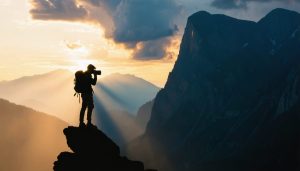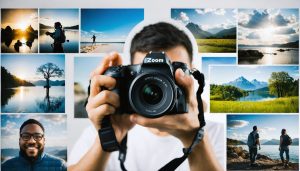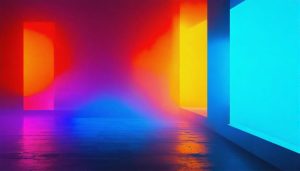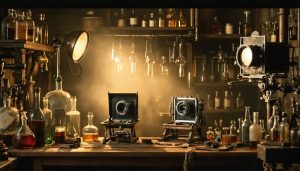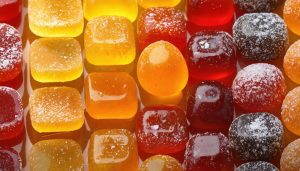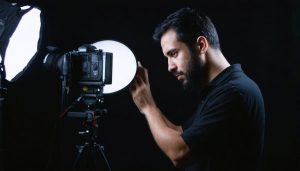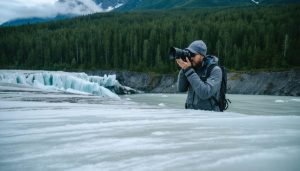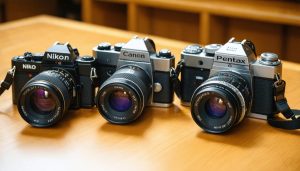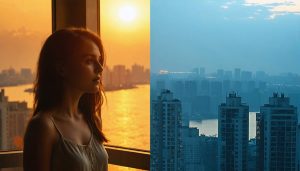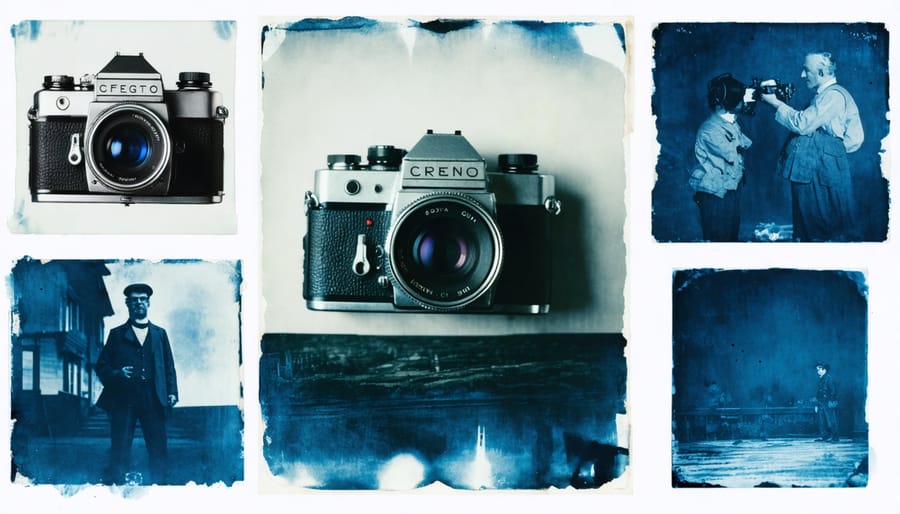
Step back in time and uncover the enchanting world of vintage photography techniques that have shaped the art form we know today. From the ethereal glow of daguerreotypes to the dreamy softness of film photography, these time-honored methods offer a gateway to creating images imbued with nostalgia and timeless beauty. Delve into the rich history behind techniques like cyanotypes, tintypes, and the captivating process of wet plate collodion. Discover how these manual, hands-on approaches fostered a deep connection between photographer and subject, demanding patience, skill, and a keen eye for composition. As you explore each technique’s unique characteristics and visual signatures, you’ll gain a newfound appreciation for the pioneers who pushed the boundaries of the medium. Join us on this journey as we celebrate the enduring allure of old photography techniques and their power to transport us to another era.
Daguerreotype: The Pioneer
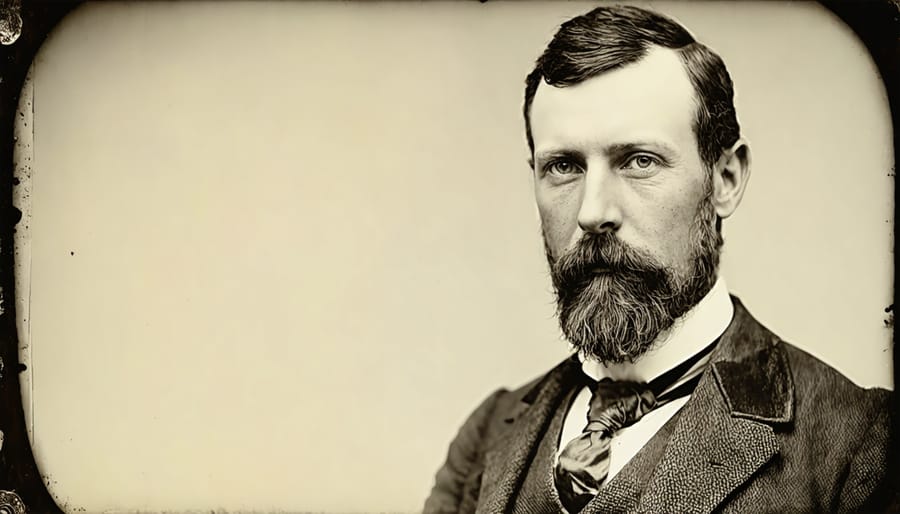
Creating a Daguerreotype
Creating a daguerreotype was a delicate and time-consuming process. First, a silver-plated copper plate was polished to a mirror-like finish using various abrasives and buffing compounds. The plate was then sensitized to light by exposing it to iodine fumes in a specially designed fuming box, forming a thin layer of light-sensitive silver iodide on the surface.
Next, the sensitized plate was placed in a camera obscura and exposed to light for several minutes, depending on the brightness of the scene. After exposure, the plate was developed over heated mercury vapor, which adhered to the silver iodide in proportion to the amount of light that had struck each area during exposure. This created a visible image on the plate.
To fix the image and prevent further light sensitivity, the plate was immersed in a solution of sodium thiosulfate or salt water. Finally, the delicate surface was rinsed, dried, and sealed behind glass to protect it from damage and tarnishing. The resulting unique, one-of-a-kind image had a haunting, mirror-like quality with intricate details and subtle tonal gradations that captivated viewers.
Calotype: The Paper Negative
Advantages of Calotypes
One of the key advantages of calotypes was their ability to capture a wide range of tones and detail, resulting in images with a distinctive, soft, and dreamy aesthetic. The paper negative process allowed for greater control over contrast and exposure, enabling photographers to create prints with a unique artistic quality that differed from the sharp precision of daguerreotypes.
Calotypes also offered the significant benefit of reproducibility. Unlike daguerreotypes, which were one-of-a-kind images on metal plates, calotype negatives could be used to create multiple positive prints. This opened up new possibilities for sharing and distributing photographs, paving the way for the widespread dissemination of images in books, albums, and exhibitions.
The calotype process was more forgiving than daguerreotypes, as the paper negative could be slightly overexposed without significant loss of image quality. This allowed for greater flexibility in capturing subjects under varying lighting conditions.
Wet Plate Collodion: The Artistic Medium
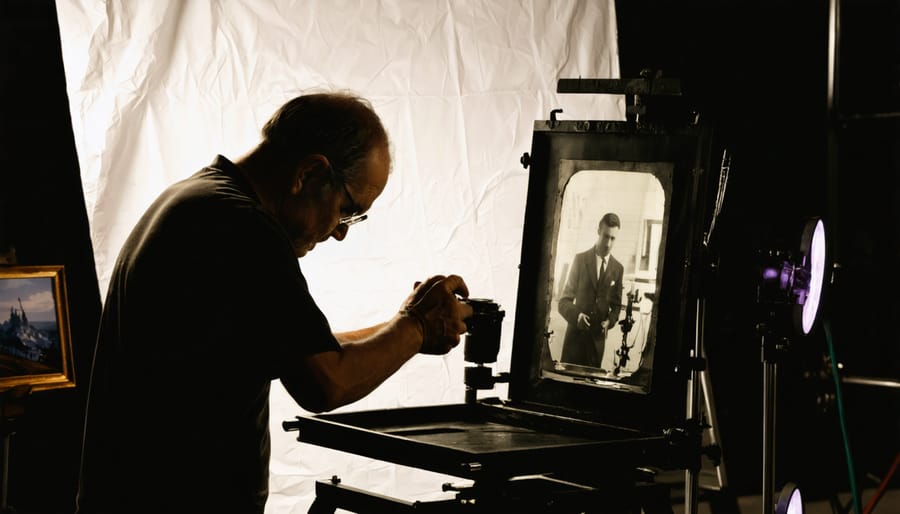
Mastering the Collodion Process
Here are some tips for mastering the wet plate collodion process:
First, pay close attention to your chemistry. The collodion solution, silver nitrate bath, and developer all need to be mixed precisely and kept at the right temperatures for optimal results. Regularly check the specific gravity of your silver bath.
Pouring the collodion evenly onto the plate takes practice. Tilt and rotate the plate to get full coverage without ripples or dry spots. After sensitizing, keep the plate level as you load it into the plate holder.
Exposure times will vary based on your lens and lighting conditions, often ranging from a few seconds to a few minutes. Experiment and take detailed notes to dial in the right settings. Slightly overexposing tends to produce better results than underexposing.
Developing requires a delicate touch – pour the developer evenly, then gently rock the tray to ensure even coverage. Watch closely and stop development when highlights have the desired density. Fix and wash the plate according to established methods.
Safety is crucial when working with the chemicals involved in this process. Always wear gloves, goggles, and work in a well-ventilated area. Properly dispose of chemical waste.
With practice and patience, you’ll start producing unique one-of-a-kind photographs with the timeless look of the wet plate collodion process. Embrace the imperfections and happy accidents along the way – they add to the charm and character of this handcrafted photographic method.
Tintype: Durable and Distinctive
Tintype photography, also known as ferrotype, emerged in the mid-19th century as a durable and affordable alternative to daguerreotypes and ambrotypes. The process involves creating a direct positive image on a thin metal plate coated with a light-sensitive emulsion. Tintypes are renowned for their distinctive look, characterized by a slightly gritty and raw aesthetic that lends a timeless quality to the photographs.
One of the most appealing aspects of tintypes is their unique tonal range. The images often feature a warm, slightly sepia-toned appearance, with deep blacks and creamy highlights. The metallic surface of the plate can also contribute to the image’s character, sometimes resulting in a subtle sheen or reflectivity that adds depth and dimension to the photograph.
Tintypes are also prized for their durability. Unlike paper prints, which can fade or deteriorate over time, tintypes are resistant to wear and tear, making them ideal for long-term preservation. This durability has contributed to the survival of countless historical tintypes, providing valuable glimpses into the past.
In modern photography, the tintype aesthetic can be emulated through various techniques, such as applying sepia tones or using 3-point lighting setups to achieve the characteristic look. By understanding the unique qualities of tintypes, photographers can draw inspiration from this classic process and incorporate its timeless charm into their own work.
Cyanotype: The Blueprint
Cyanotype, a photographic printing process developed in the 1840s, is known for its distinctive blue hue. This technique involves coating paper or fabric with a solution of ferric ammonium citrate and potassium ferricyanide, then exposing it to sunlight with a negative or objects placed on top. The UV light triggers a chemical reaction, resulting in the characteristic Prussian blue color.
To create a cyanotype, mix equal parts of the two chemicals and apply the solution evenly to your chosen surface. Once dry, place a negative or arrange objects on the coated paper, then expose it to sunlight for several minutes. The exposure time varies depending on the intensity of the sunlight and the desired effect. After exposure, rinse the print in water to remove any unexposed chemicals and reveal the final blue image.
Cyanotypes offer a unique aesthetic with their monochromatic blue tones and slight variations in hue. This process is versatile, allowing you to create prints from both photographic negatives and physical objects, such as leaves or lace. Experimenting with different exposure times and objects can yield intriguing abstract or photogram-style images. With its simplicity and room for creativity, the cyanotype process remains a fascinating avenue for photographers and artists to explore.
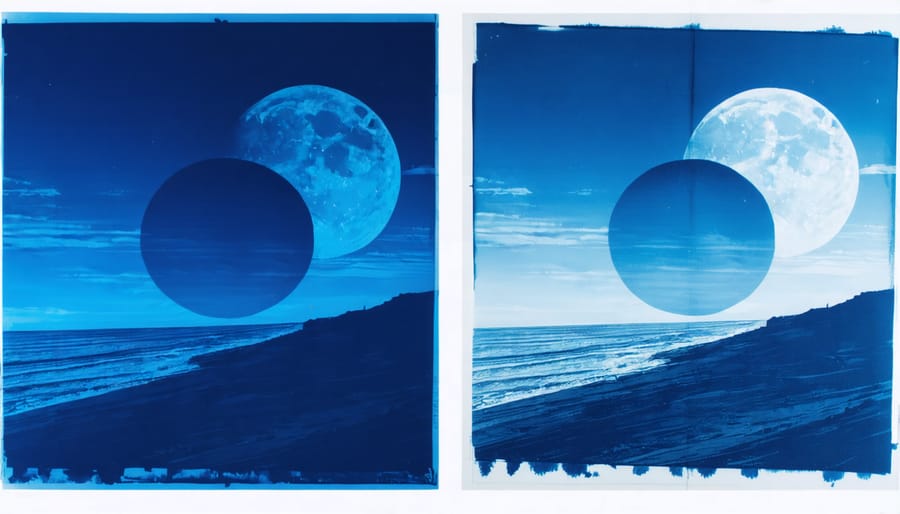
Gum Bichromate: Painterly Prints
The gum bichromate process, popular in the late 19th and early 20th centuries, is a unique photographic printing technique that produces stunning, painterly results. This process involves coating paper with a mixture of gum arabic, potassium or ammonium dichromate, and pigment. When exposed to UV light through a negative, the gum hardens in proportion to the amount of light received. The unexposed areas are then washed away, leaving behind a beautifully textured, hand-crafted print.
One of the most appealing aspects of gum bichromate printing is the level of creative control it offers. By varying the pigment color, the number of coatings, and the exposure time, photographers can create prints with a wide range of tonal values and hues. The process also allows for local manipulation, such as brushing away certain areas or applying additional layers of pigment, resulting in truly one-of-a-kind, expressive images.
While gum bichromate printing requires patience and practice to master, the results are well worth the effort. The soft, dreamy quality of the prints evokes a sense of timelessness and nostalgia, making this technique a favorite among fine art photographers and those seeking to add an artistic touch to their work.
Applying Old Techniques in the Digital Age
Digital Tools for Emulating Old Techniques
While digital cameras offer incredible convenience and image quality, many photographers still crave the unique character of vintage photographs. Fortunately, a variety of software tools can help you achieve those classic looks without the need for old cameras or darkroom equipment. Adobe Lightroom and Photoshop are popular choices, offering a wide range of presets and editing tools to emulate film stocks, vignettes, grain, and more. Nik Collection by DxO is another powerful suite of plugins that includes vintage camera and lens simulations. For a more automated approach, apps like VSCO, RNI Films, and Mastin Labs provide one-click preset packs designed to mimic specific film types and eras. These tools often include adjustable settings for fine-tuning the intensity and character of the effect. When using digital tools to recreate old techniques, it’s essential to study the characteristics of the original methods and aim for subtlety in your edits. Experiment with different combinations of settings to find what works best for each image, and don’t be afraid to blend multiple techniques for a truly unique vintage look. With practice and attention to detail, you can infuse your digital photos with the timeless charm of analog photography.
Conclusion
In conclusion, old photography techniques aren’t just relics of a bygone era—they hold invaluable lessons for modern photographers. By studying and experimenting with these vintage methods, we gain a deeper appreciation for the craftsmanship and creativity that defined early photography. Preserving this knowledge allows us to expand our artistic toolkits, drawing inspiration from the unique aesthetics and limitations of each technique.
Moreover, understanding the history behind these techniques gives us insight into how photography has evolved over time. As we embrace the conveniences of digital photography, it’s important not to lose sight of the ingenuity and skill that paved the way for today’s advancements. By keeping old techniques alive through practice and education, we ensure that future generations can continue learning from and building upon the rich legacy of photographic art.

